Study of the Impact of Aerodynamic Model Fidelity on the Flight Characteristics of Unconventional Aircraft
Abstract
:1. Introduction
2. Model
3. Aerodynamics
3.1. Wind Tunnel Investigation
3.2. Numerical Computation
3.2.1. Physical and Mathematical Models
- -
- continuity equation
- -
- Euler equation:
- -
- state equation:
3.2.2. CFD Software
4. Dynamics
4.1. Physical Model
- The aircraft is a rigid body with six degrees of freedom:
- Three translations along the axis—x,y,z;
- Three rotations—pitch, roll, yaw;
- Control surfaces are movable but cannot perform free vibrations;
- The atmosphere is conformable with standard atmosphere
- The atmosphere is not disturbed and windless—the effect of wind can be modeled by modifying the airspeed vector.
4.2. Mathematical Model
4.3. Linearization
5. Results
5.1. Aerodynamics
5.2. Stability Derivatives
5.3. Stability Characteristics
5.4. Maneuvers
6. Conclusions
- Good accordance was achieved for longitudinal derivatives. The biggest difference was noticed for , which is associated with lack of a cross-flow modeling in PANUKL—linear moment characteristics without pitch-up. The difference becomes lower with Mach number, where the pitch-up effect is less present.
- In the case of directional derivatives, the biggest difference was noticed for . This is associated with the geometry of the side plates that have a significant contribution in the yaw moment. Due to a significant dihedral angle, the flow around the side plates should be considered in the nonlinear range with a vortex (Figure 11); therefore, PANUKL underestimated these derivatives.
- Good accordance was achieved for all dynamic tests for all source data, despite some differences in aerodynamic characteristics and stability derivatives; for all data sets, the qualitative results were the same (acceptable or not, according to stability criteria), and the differences were only quantitative:
- –
- For the phugoid mode, a higher damping ratio was noticed for the wind tunnel data. In the pure numerical data, the difference in damping for low speed was negligible, while for higher speed, the damping was stronger for the MGAERO case due to presence of the compressible effect on the drag coefficient. The phugoid was the mode where the differences obtained between results were the biggest.
- –
- For the short-period mode, the differences in both the damping ratio and undampened natural frequency were negligible. The short period was the mode where the differences obtained between results were the smallest.
- –
- For the Dutch roll mode, a stronger damping ratio was noticed for the MGAERO data set, while the lowest damping ratio occurred for the wind tunnel data.
- The potential method is quite efficient and good enough to estimate dynamic characteristics for the subsonic range and moderate angles of attack.
- The use of the potential flow method to assess handling qualities of even an unconventional configuration can be utilized in the preliminary stage of design.
Author Contributions
Funding
Institutional Review Board Statement
Informed Consent Statement
Data Availability Statement
Conflicts of Interest
References
- Goetzendorf-Grabowski, T. Flight dynamics of unconventional configurations. Prog. Aerosp. Sci. 2023, 137, 100885. [Google Scholar] [CrossRef]
- Rizzi, A. Modeling and simulating aircraft stability and control—The SimSAC project. Prog. Aerosp. Sci. 2011, 47, 573–588. [Google Scholar] [CrossRef]
- Smith, H.; Sziroczák, D.; Abbe, G.; Okonkwo, P. The GENUS aircraft conceptual design environment. Proc. Inst. Mech. Eng. Part J. Aerosp. Eng. 2018, 233, 2932–2947. [Google Scholar] [CrossRef]
- Mieloszyk, J.; Goetzendorf-Grabowski, T. Introduction of full flight dynamic stability constraints in aircraft multidisciplinary optimization. Aerosp. Sci. Technol. 2017, 68, 252–260. [Google Scholar] [CrossRef]
- Ciampa, P.D.; Prakasha, P.S.; Torrigiani, F.; Walther, J.N.; Lefebvre, T.; Bartoli, N.; Timmermans, H.; Vecchia, P.D.; Stingo, L.; Rajpal, D.; et al. Streamlining cross-organizational aircraft development: Results from the AGILE project. In Proceedings of the AIAA Aviation 2019 Forum, Dallas, TX, USA, 17–21 June 2019; American Institute of Aeronautics and Astronautics: Reston, VA, USA, 2019. [Google Scholar] [CrossRef]
- Mieloszyk, J.; Tarnowski, A.; Tomaszewski, A.; Goetzendorf-Grabowski, T. Validation of flight dynamic stability optimization constraints with flight tests. Aerosp. Sci. Technol. 2020, 106, 106193. [Google Scholar] [CrossRef]
- Reist, T.A.; Zingg, D.W.; Rakowitz, M.; Potter, G.; Banerjee, S. Multifidelity Optimization of Hybrid Wing–Body Aircraft with Stability and Control Requirements. J. Aircr. 2019, 56, 442–456. [Google Scholar] [CrossRef]
- Goetzendorf-Grabowski, T.; Rizzi, A.; Molitor, P.; Vos, J.B.; Sanchi, S.; Tomac, M. Coupling adaptive-fidelity CFD with S&C analysis to predict flying qualities. In Proceedings of the 27th AIAA Applied Aerodynamics Conference, San Antonio, TX, USA, 22–25 June 2009; American Institute of Aeronautics and Astronautics: Reston, VA, USA, 2009. [Google Scholar] [CrossRef]
- Mi, B.; Zhan, H. Review of Numerical Simulations on Aircraft Dynamic Stability Derivatives. Arch. Comput. Methods Eng. 2019, 27, 1515–1544. [Google Scholar] [CrossRef]
- Ghoreyshi, M.; Badcock, K.; Woodgate, M. Integration of multi-fidelity methods for generating an aerodynamic model for flight simulation. In Proceedings of the 46th AIAA Aerospace Sciences Meeting and Exhibit, Reno, NV, USA, 7–10 January 2008; American Institute of Aeronautics and Astronautics: Reston, VA, USA, 2008. [Google Scholar] [CrossRef]
- Goetzendorf-Grabowski, T. Influence of stability derivatives on a quality of simulation (supersonic flow). J. Theor. Appl. Mech. 1994, 32, 773–791. [Google Scholar]
- ESDU—Engineering Sciences Data Unit. 2022. Available online: https://www.esdu.com (accessed on 1 December 2022).
- Finck, R.D. USAF (United States Air Force) Stability and Control DATCOM (Data Compendium); Technical Report AFWAL-TR-83-3048, 1975–1977; Defense Technical Information Center: Fort Belvoir, VA, USA, 1978.
- Ciliberti, D.; Vecchia, P.D.; Nicolosi, F.; Marco, A.D. Aircraft directional stability and vertical tail design: A review of semi-empirical methods. Prog. Aerosp. Sci. 2017, 95, 140–172. [Google Scholar] [CrossRef]
- Gatto, A.; Lowenberg, M.H. Evaluation of a Three Degree of Freedom Test Rig for Stability Derivative Estimation. J. Aircr. 2006, 43, 1747–1761. [Google Scholar] [CrossRef]
- Goetzendorf-Grabowski, T. Multi-disciplinary optimization in aeronautical engineering. Proc. Inst. Mech. Eng. Part J. Aerosp. Eng. 2017, 231, 2305–2313. [Google Scholar] [CrossRef]
- Figat, M.; Galiński, C.; Kwiek, A. Modular aeroplane system—A concept and initial investigation. In Proceedings of the 28th Congress of the International Council of the Aeronautical Sciences, ICAS, Brisbane, Australia, 23–28 September 2012. [Google Scholar]
- Galiński, C.; Goetzendorf-Grabowski, T.; Mieszalski, D.; Stefanek, L. A concept of two-staged spaceplane for suborbital tourism. Trans. Inst. Aviat. 2007, 191, 33–42. [Google Scholar]
- Ansari Prize. 2023. Available online: https://www.xprize.org/prizes/ansari (accessed on 24 March 2023).
- Polhamus, E.C. A Concept of the Vortex Lift of Sharp-Edge Delta Wings Based on a Leading-Edge-Suction Analogy; NASA Technical Note NASA-TN-D-3767; Langley Research Center: Hampton, VA, USA, 1966. [Google Scholar]
- Kwiek, A.; Figat, M.; Goetzendorf-Grabowski, T. The Study of Selected Aspects of the Suborbital Vehicle Return Flight Trajectory. Aerospace 2023, 10, 489. [Google Scholar] [CrossRef]
- Figat, M.; Kwiek, A. Aerodynamic optimisation of the rocket plane in subsonic and supersonic flight conditions. Proc. Inst. Mech. Eng. Part J. Aerosp. Eng. 2017, 231, 2266–2281. [Google Scholar] [CrossRef]
- Kwiek, A. Study on control and stability of the rocket plane to space tourism. In Proceedings of the 29th Congress of the International Council of the Aeronautical Sciences, ICAS, St. Petersburg, Russia, 7–12 September 2014. [Google Scholar]
- Witoszyński, C. Travaux de L’Institut Aerodynamique de Varsovie; WUT: Wuhan, China, 1932; Volume V, (In Polish and French). [Google Scholar]
- Kwiek, A.; Figat, M. LEX and wing tip plates’ interaction on the Rocket Plane in tailless configuration. Aeronaut. J. 2016, 120, 255–270. [Google Scholar] [CrossRef]
- Kwiek, A.; Figat, M. An investigation into directional characteristics of the rocket plane in a tailless configuration. CEAS Space J. 2022, 15, 627–640. [Google Scholar] [CrossRef]
- Li, L.; Xu, W.; Tan, Y.; Yang, Y.; Yang, J.; Tan, D. Fluid-induced vibration evolution mechanism of multiphase free sink vortex and the multi-source vibration sensing method. Mech. Syst. Signal Process. 2023, 189, 110058. [Google Scholar] [CrossRef]
- Li, L.; Gu, Z.; Xu, W.; Tan, Y.; Fan, X.; Tan, D. Mixing mass transfer mechanism and dynamic control of gas-liquid-solid multiphase flow based on VOF-DEM coupling. Energy 2023, 272, 127015. [Google Scholar] [CrossRef]
- Hess, J. Review of the historical development of surface source methods. In Computational Methods in Potential Aerodynamics; Morino, L., Ed.; Springer: Berlin/Heidelberg, Germany, 1985. [Google Scholar]
- Goraj, Z.; Pietrucha, J. Classical Panel—A Routine Tool for Aerodynamic Calculations of Complex Aircraft Configurations: From Concept To Codes. J. Theor. Appl. Mech. 1995, 33, 843–878. [Google Scholar]
- Figat, M.; Goetzendorf-Grabowski, T.; Goraj, Z. Aerodynamic calculation of unmanned aircraft. Aircr. Eng. Aerosp. Technol. 2005, 77, 467–474. [Google Scholar] [CrossRef]
- Katz, J.; Plotkin, A. Low-speed aerodynamics. In Cambridge Aerospace Series, 2nd ed.; Number 13; Cambridge University Press: Cambridge, MA, USA, 2008. [Google Scholar]
- MGAERO. A Cartesian Multigrid Euler Code for Flow Around Arbitrary Configurations—User’s Manual Version 3.1.4. Proc. Inst. Mech. Eng. Part J. Aerosp. Eng. 2001, 231, 2146–2162. [Google Scholar]
- PANUKL—Package to Compute the Aerodynamic Characteristics of an Aircraft Using Low Order Panel Method. 2020. Available online: https://www.meil.pw.edu.pl/add/ADD/Teaching/Software/PANUKL (accessed on 1 May 2021).
- Mavriplis, D.J. Three-dimensional unstructured multigrid for the Euler equations. AIAA J. 1992, 30, 1753–1761. [Google Scholar] [CrossRef]
- Cook, M. Flight Dynamics Principles: A Linear Systems Approach to Aircraft Stability and Control, 3rd ed.; Butterworth-Heinemann: Oxford, UK, 2012. [Google Scholar]
- Etkin, B.; Reid, L.D. Dynamics of Flight: Stability and Control, 3rd ed.; Wiley: Hoboken, NJ, USA, 1996. [Google Scholar]
- Nelson, R. Flight Stability and Automatic Control, 2nd ed.; McGraw-Hill: New York, NY, USA, 1998. [Google Scholar]
- SDSA—Simulation and Dynamic Stability Analysis Application. 2020. Available online: https://www.meil.pw.edu.pl/add/ADD/Teaching/Software/SDSA (accessed on 1 May 2021).
- Goetzendorf-Grabowski, T.; Antoniewski, T. Three surface aircraft (TSA) configuration—Flying qualities evaluation. Aircr. Eng. Aerosp. Technol. 2016, 88, 277–284. [Google Scholar] [CrossRef]
- Goetzendorf-Grabowski, T.; Mieszalski, D.; Marcinkiewicz, E. Stability analysis using SDSA tool. Prog. Aerosp. Sci. 2011, 47, 636–646. [Google Scholar] [CrossRef]
- Raymer, D.P. Aircraft Design: A Concptual Approach, 4th ed.; AIAA (American Institute of Aeronautics & Astronautics): Reston, VA, USA, 2006. [Google Scholar]
- Defense Technical Information Center. MIL-F-8785C—Military Specification Flying Qualities of Piloted Airplanes; Defense Technical Information Center: Fort Belvoir, VA, USA, 1980.
- European Aviation Safety Agency. Certification Specifications for Normal, Utility, Aerobatic, and Commuter Category Aeroplanes—CS-23, Amendment 3; European Aviation Safety Agency: Cologne, Germany, 2012. [Google Scholar]
- Kimberlin, R.D. Flight Testing of Fixed-Wing Aircraft; AIAA (American Institute of Aeronautics & Astronautics): Reston, VA, USA, 2003. [Google Scholar]
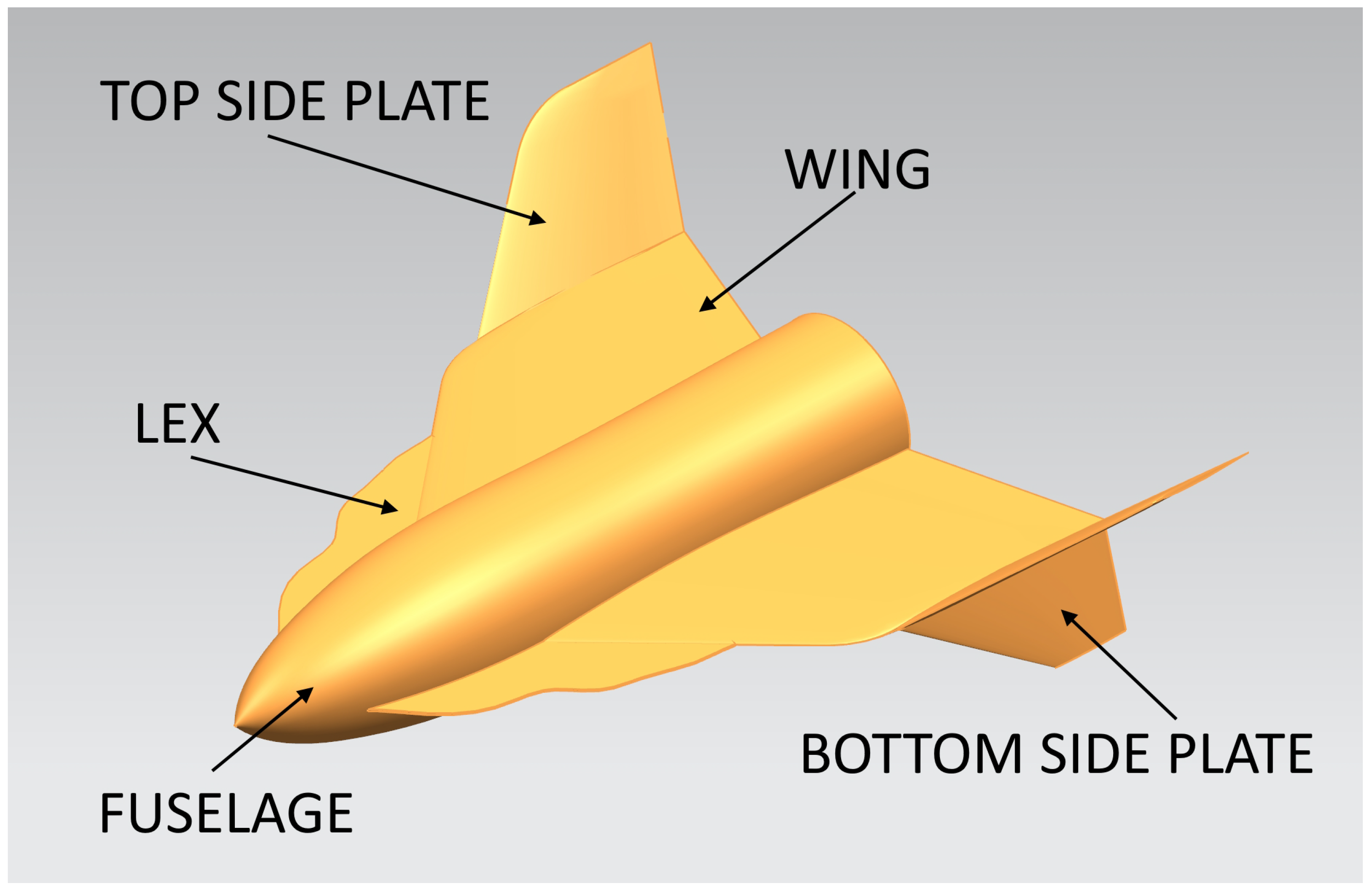

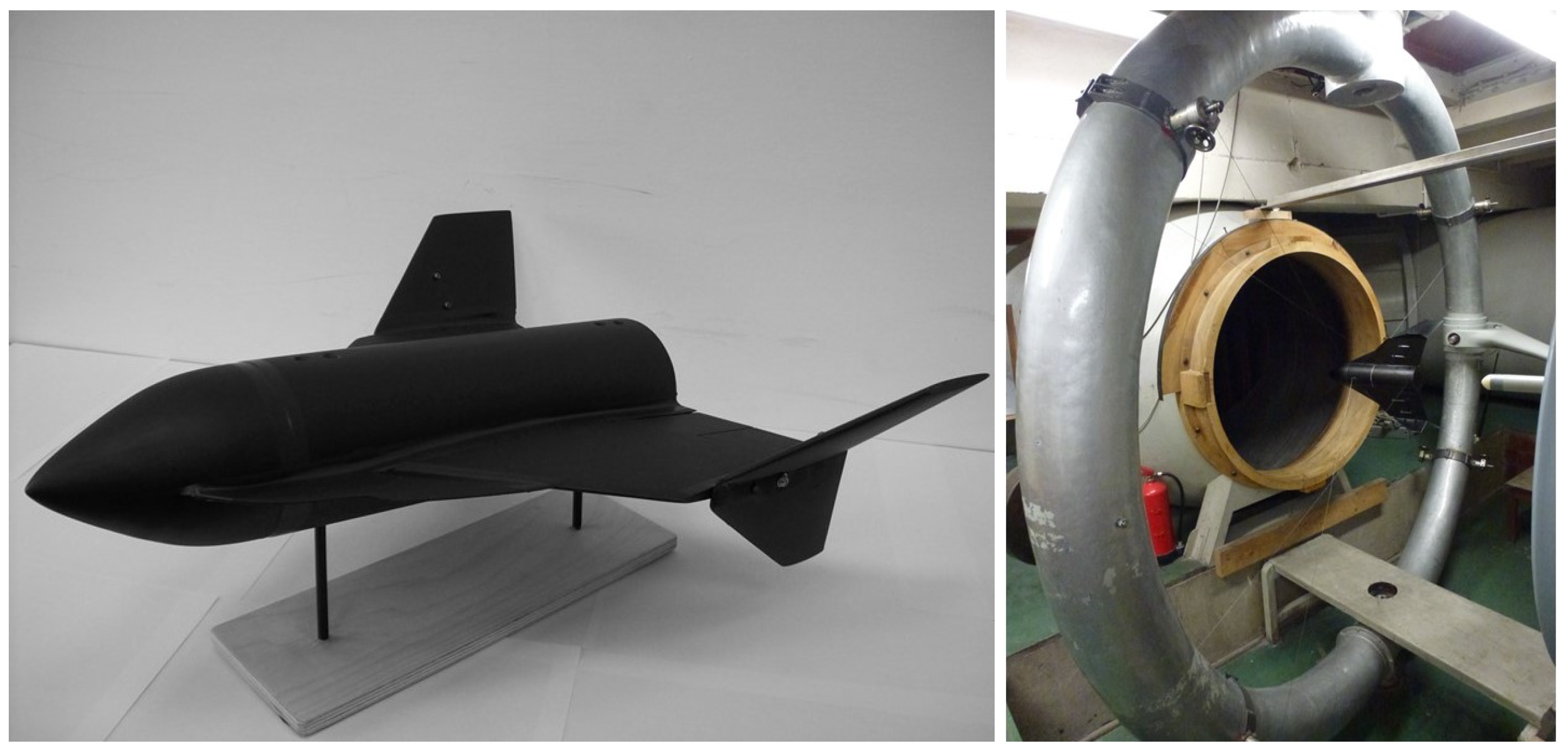
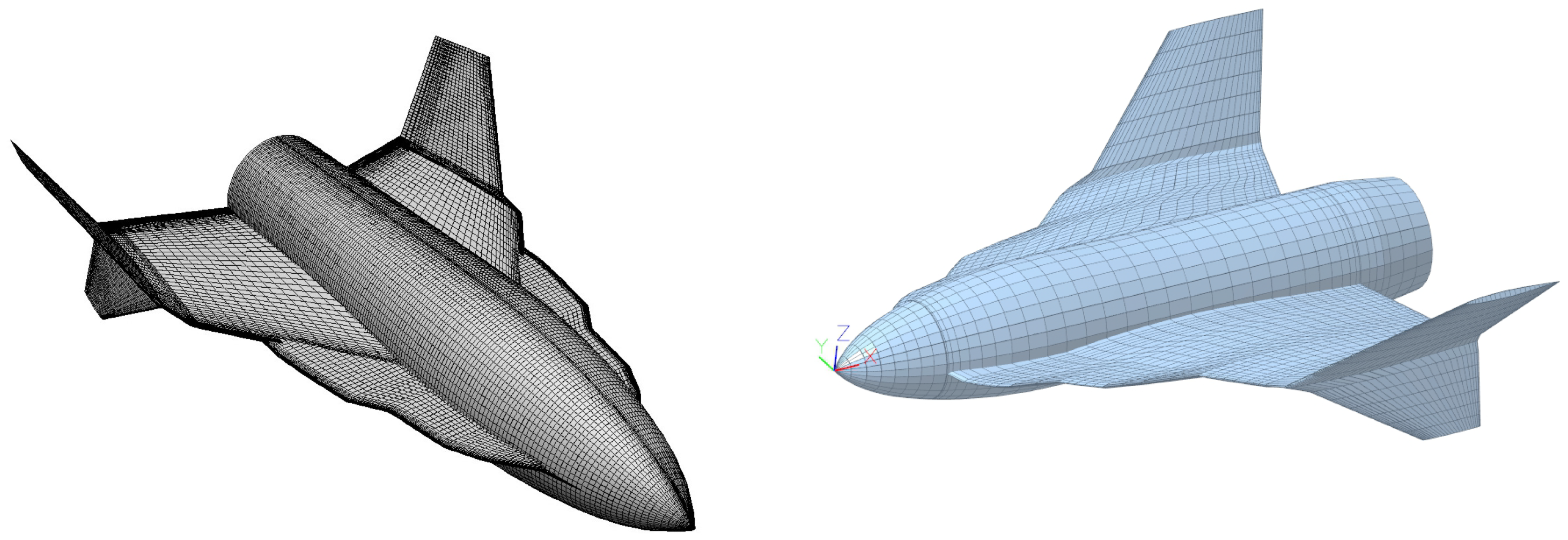
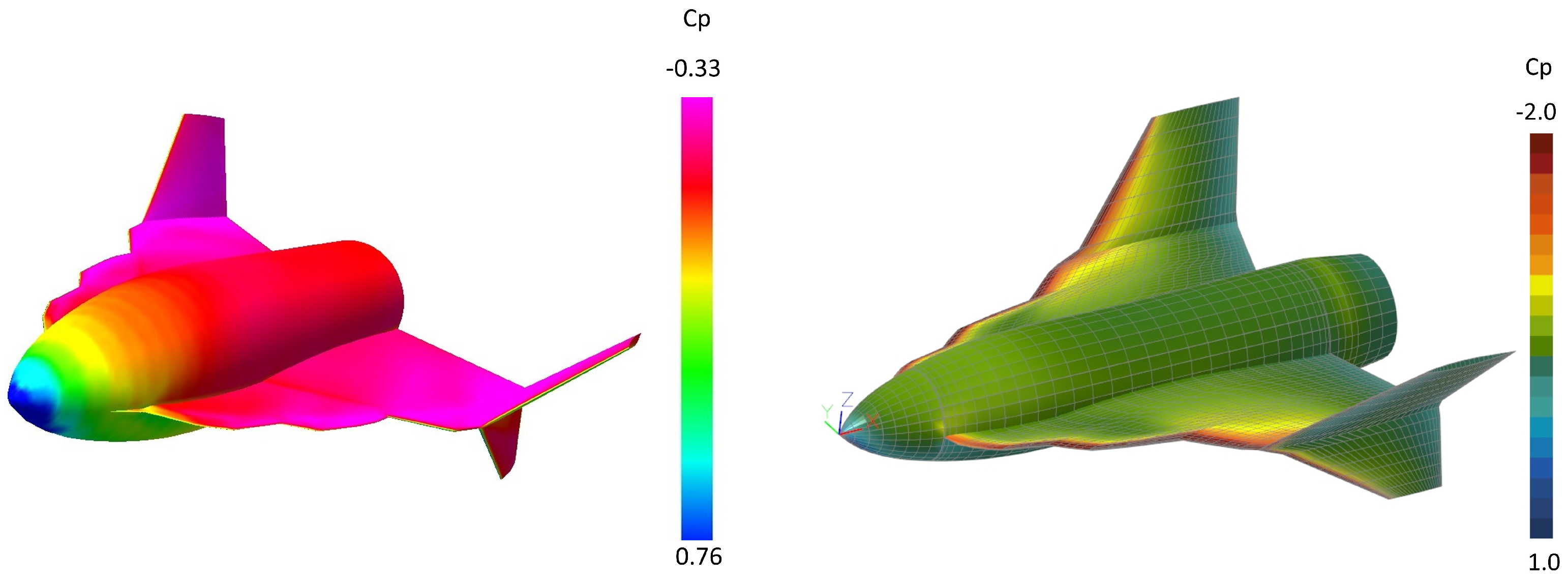

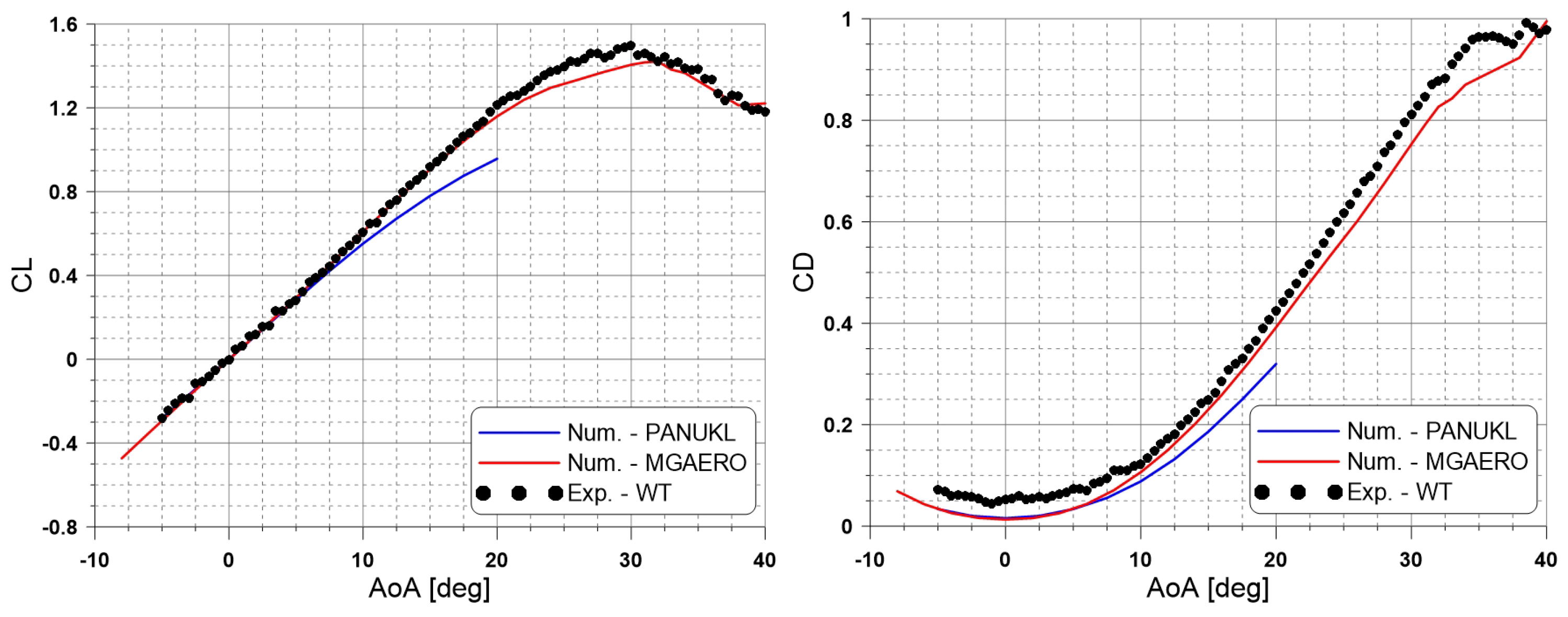
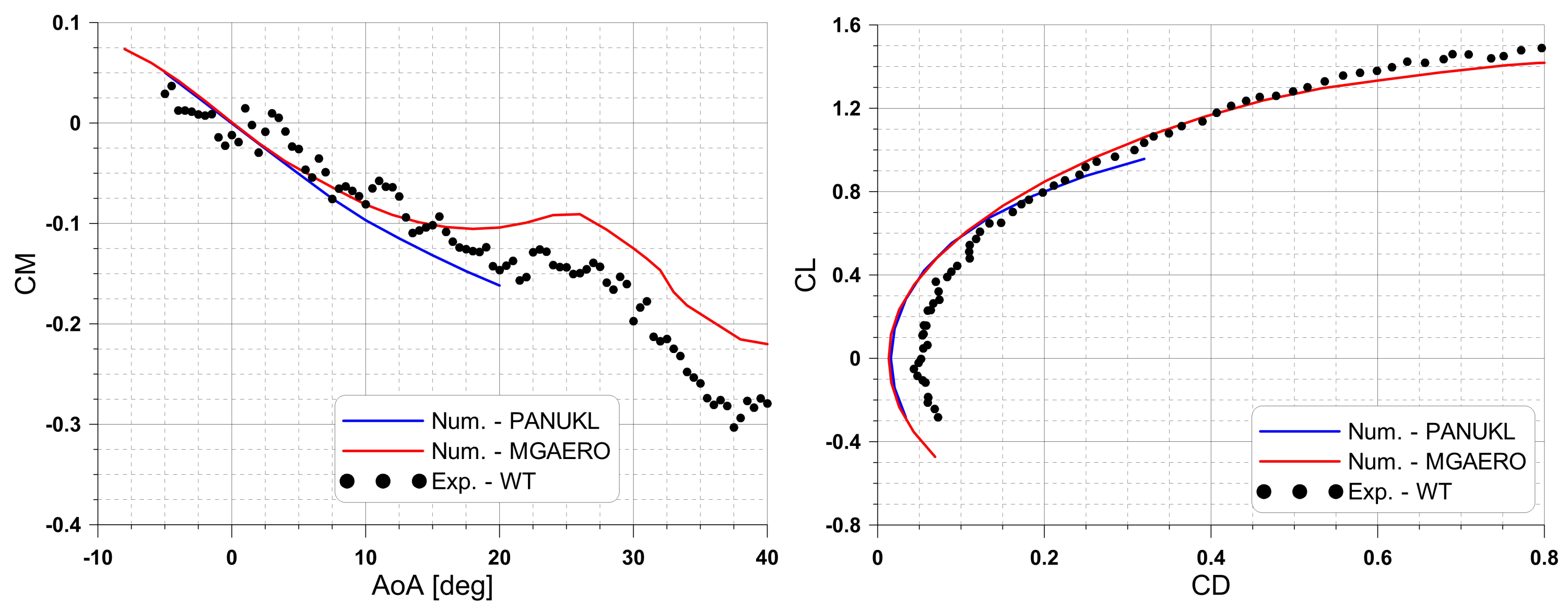
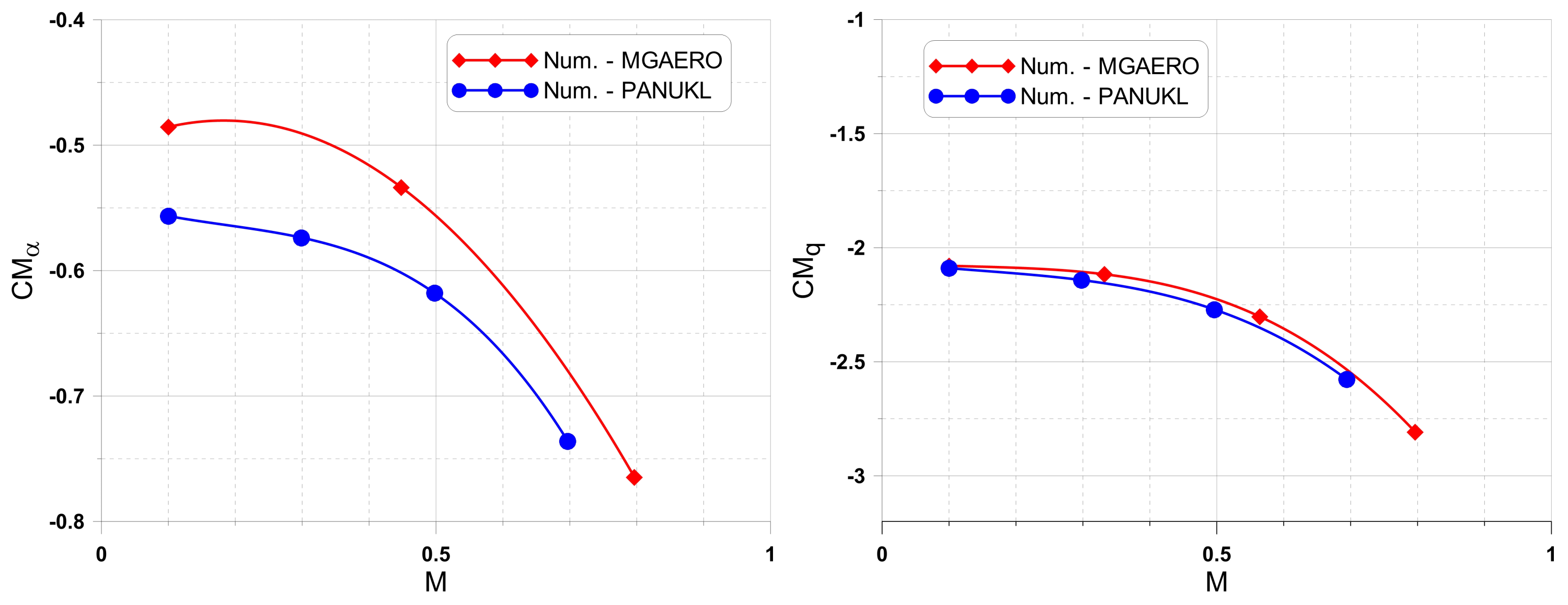
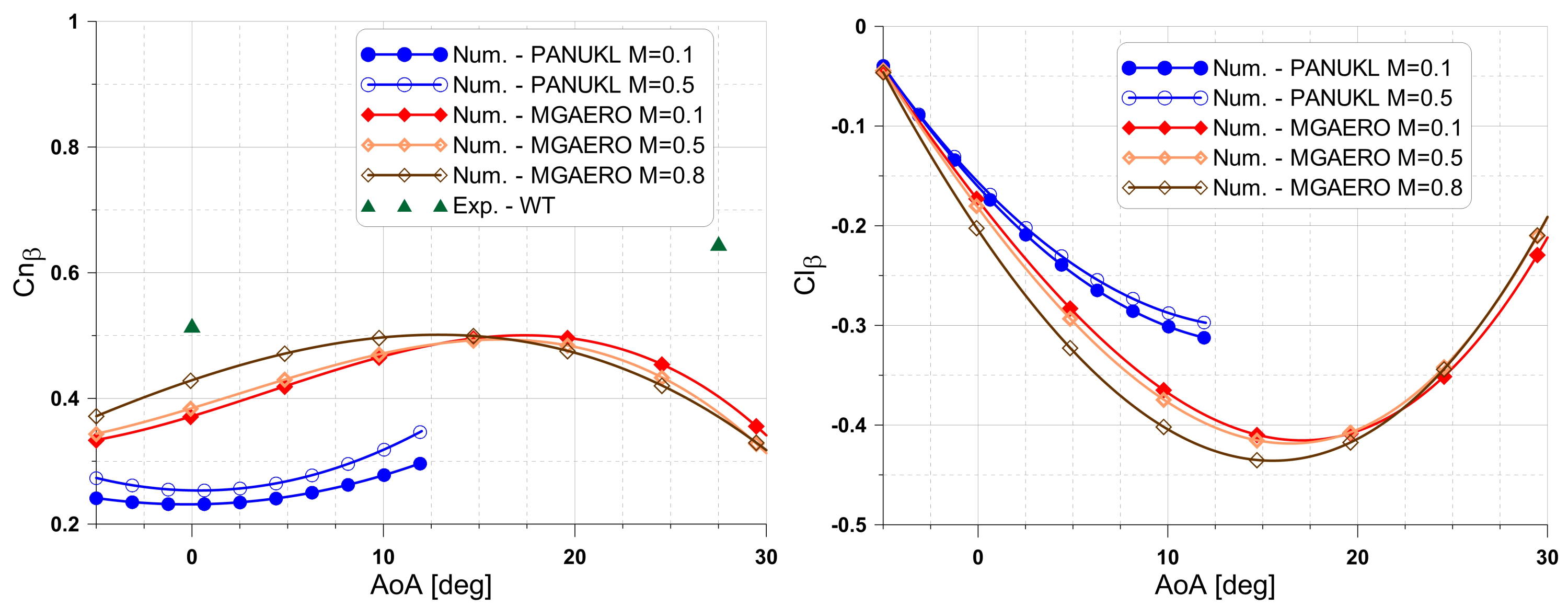

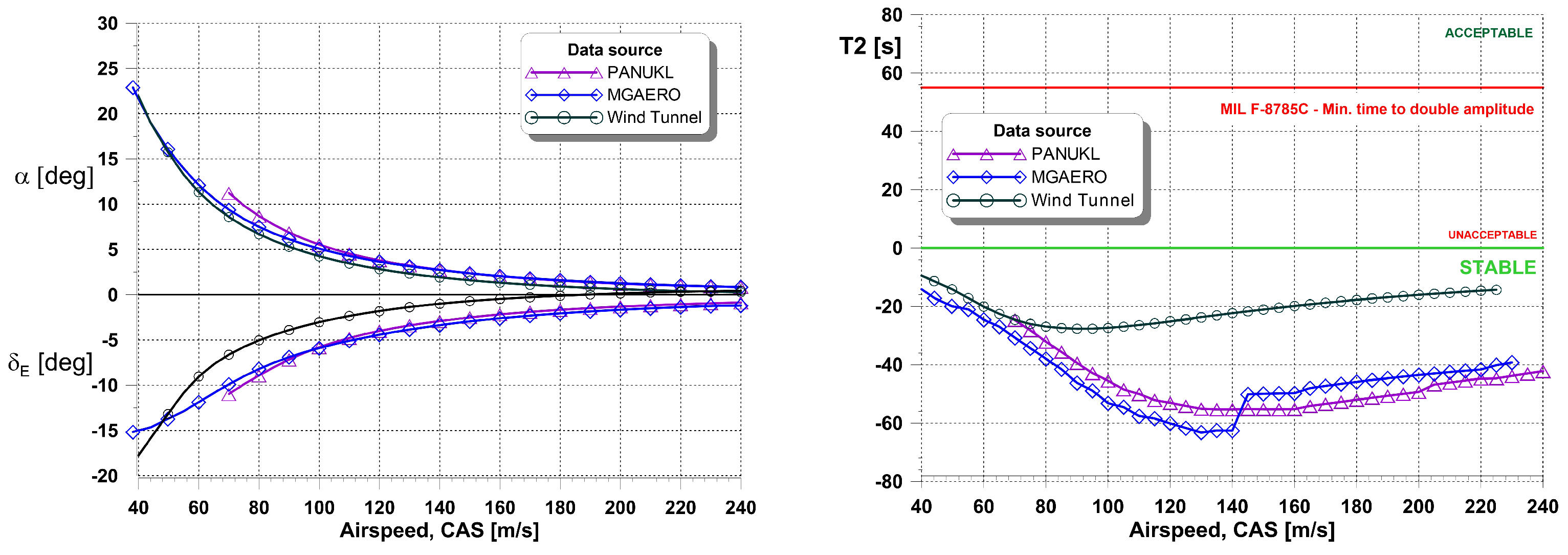
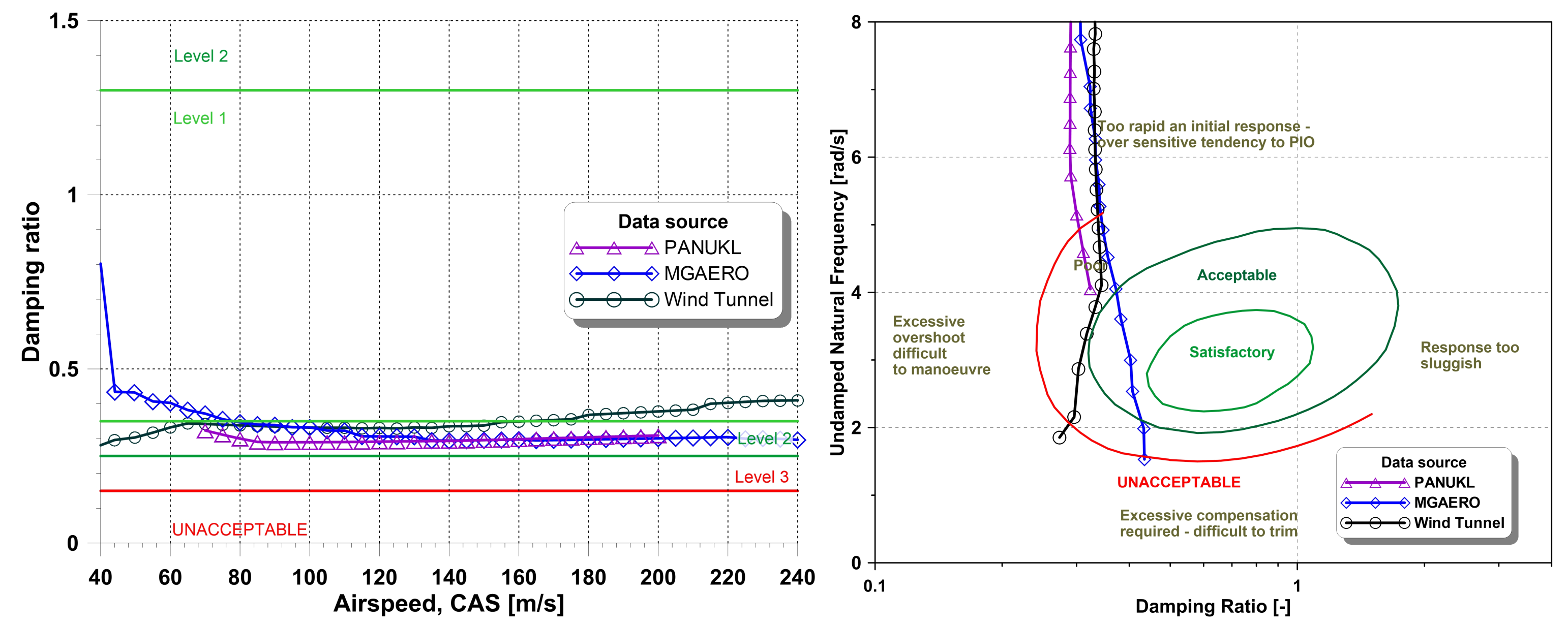
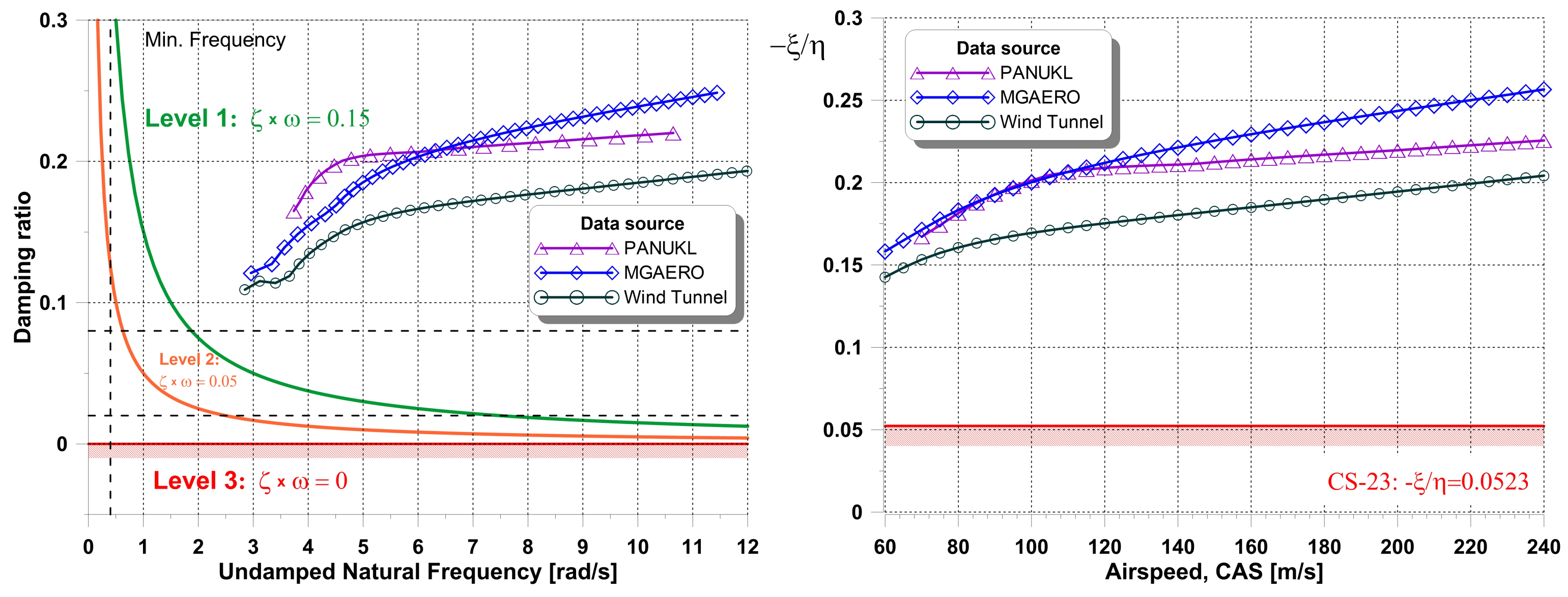
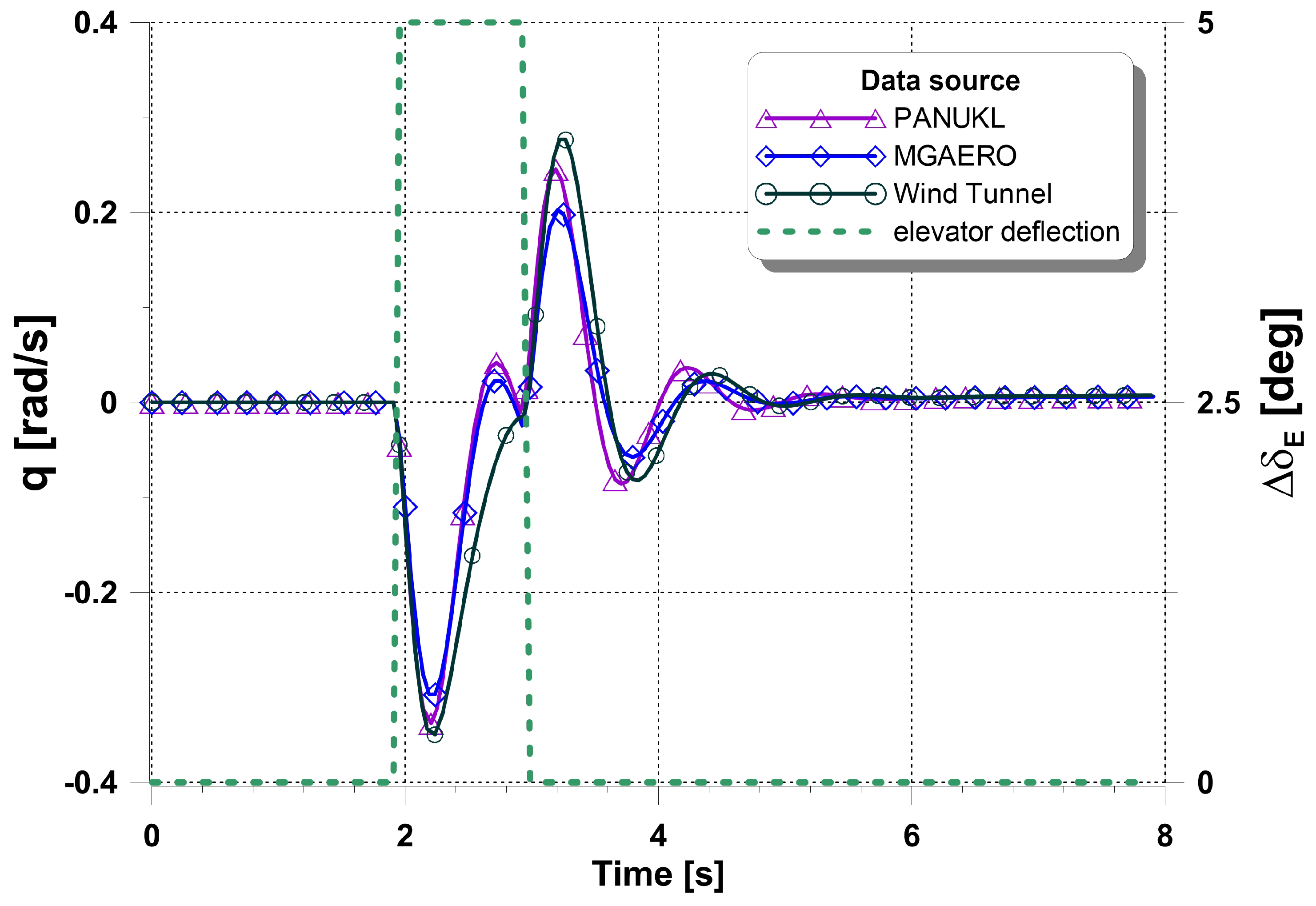
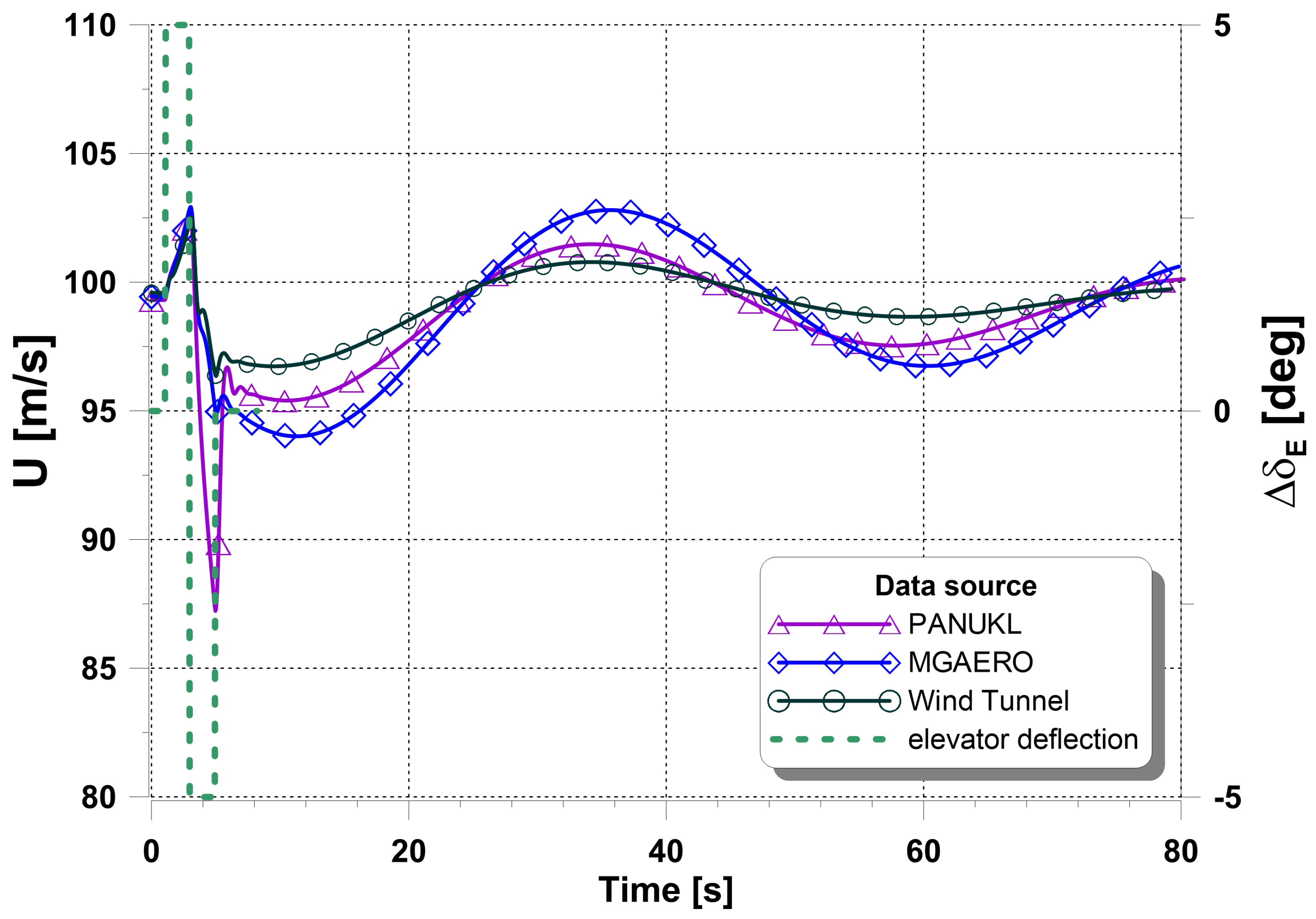

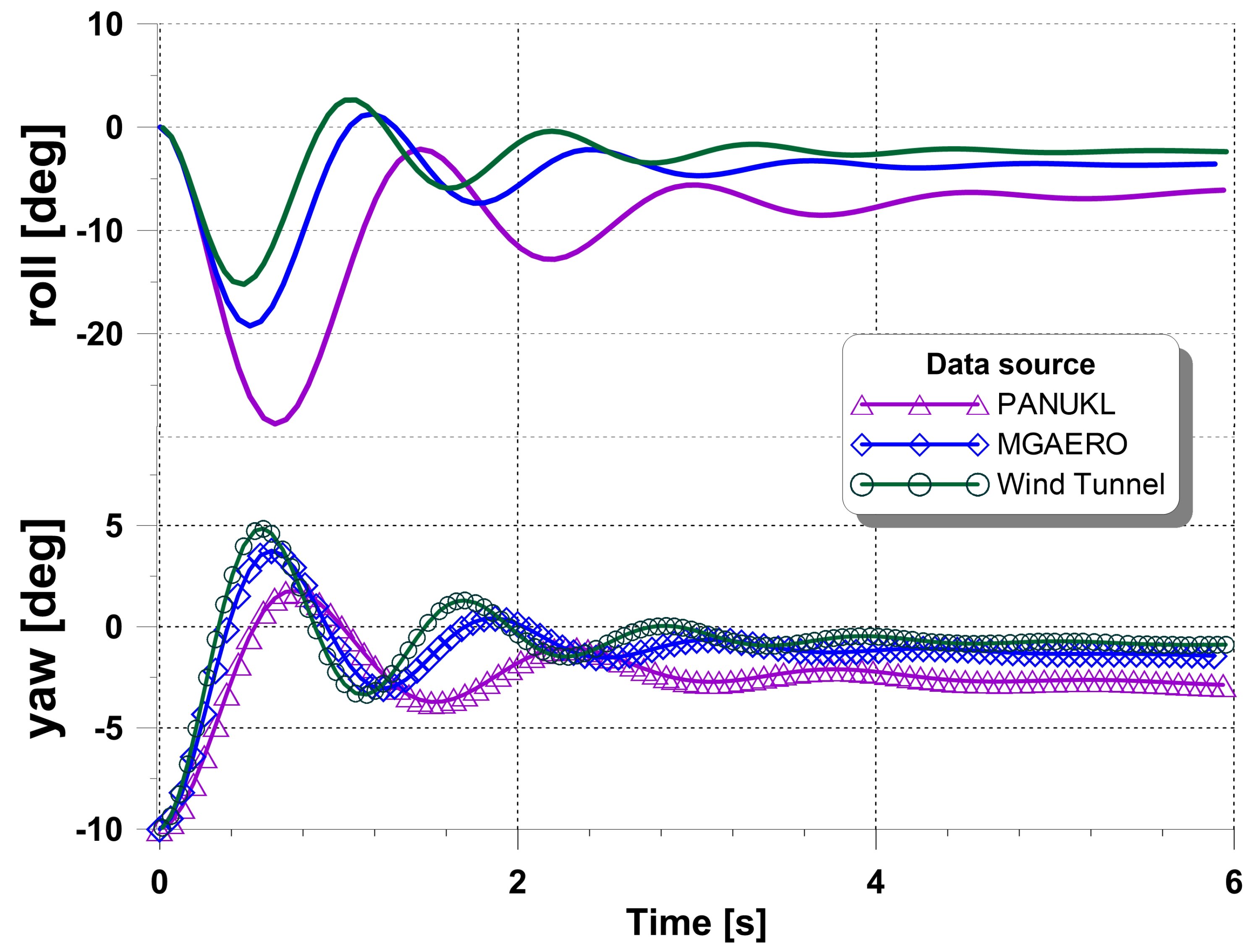
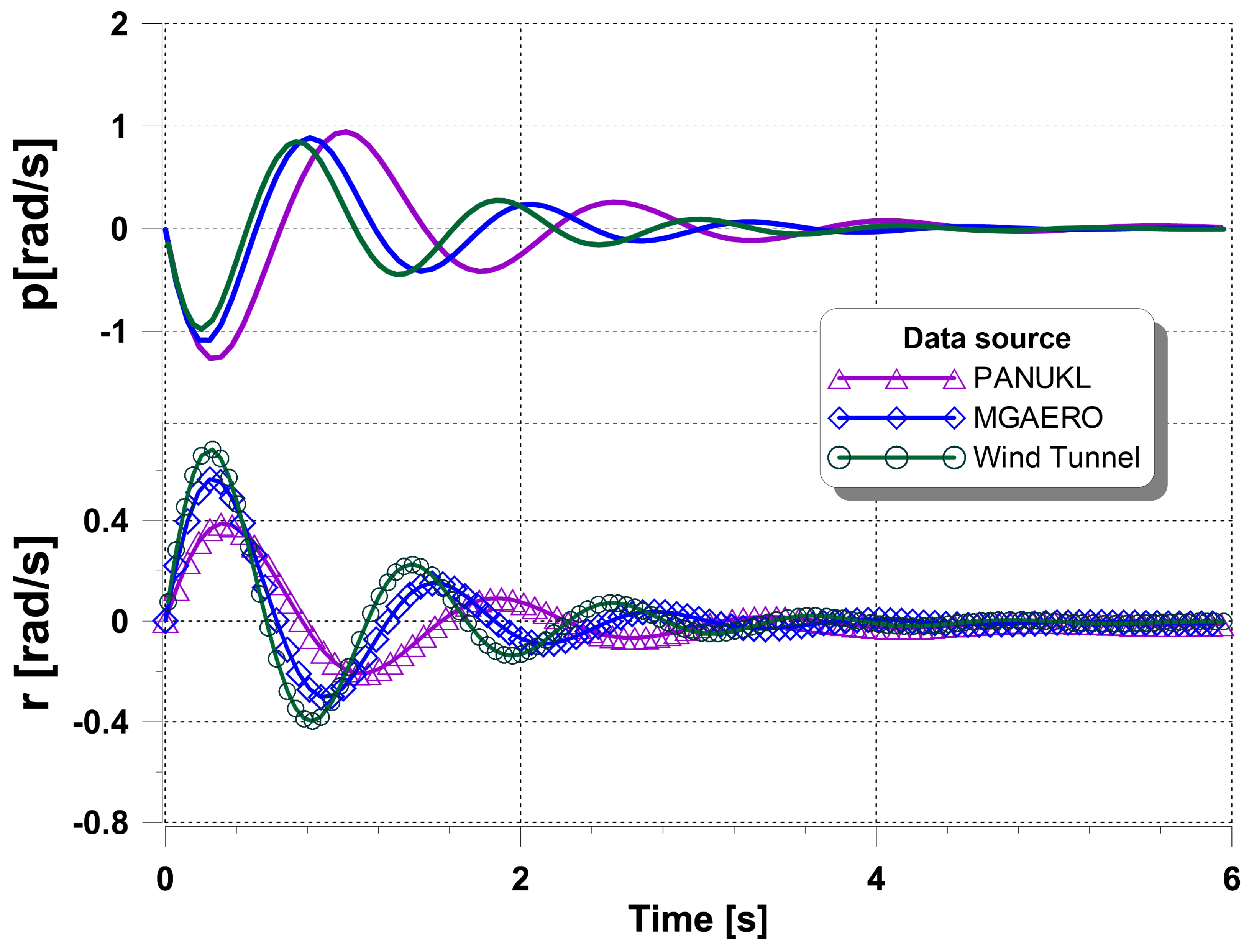
| M | Data Source | Phugoid | Short Period | Dutch Roll | |||
|---|---|---|---|---|---|---|---|
| UnF | DR | UnF | DR | UnF | DR | ||
| 0.3 | Wind Tunnel | 0.1293 | 0.1956 | 5.2252 | 0.3364 | 5.3659 | 0.1612 |
| MGAERO | 0.1282 | 0.1302 | 5.2763 | 0.3406 | 4.9947 | 0.1851 | |
| PANUKL | 0.1323 | 0.1472 | 5.7306 | 0.2906 | 4.0620 | 0.1844 | |
| 0.745 | MGAERO | 0.1282 | 0.1302 | 5.2763 | 0.3406 | 4.9947 | 0.1851 |
| PANUKL | 0.1323 | 0.1472 | 5.7306 | 0.2906 | 4.0620 | 0.1844 | |
Disclaimer/Publisher’s Note: The statements, opinions and data contained in all publications are solely those of the individual author(s) and contributor(s) and not of MDPI and/or the editor(s). MDPI and/or the editor(s) disclaim responsibility for any injury to people or property resulting from any ideas, methods, instructions or products referred to in the content. |
© 2023 by the authors. Licensee MDPI, Basel, Switzerland. This article is an open access article distributed under the terms and conditions of the Creative Commons Attribution (CC BY) license (https://creativecommons.org/licenses/by/4.0/).
Share and Cite
Goetzendorf-Grabowski, T.; Kwiek, A. Study of the Impact of Aerodynamic Model Fidelity on the Flight Characteristics of Unconventional Aircraft. Appl. Sci. 2023, 13, 12522. https://doi.org/10.3390/app132212522
Goetzendorf-Grabowski T, Kwiek A. Study of the Impact of Aerodynamic Model Fidelity on the Flight Characteristics of Unconventional Aircraft. Applied Sciences. 2023; 13(22):12522. https://doi.org/10.3390/app132212522
Chicago/Turabian StyleGoetzendorf-Grabowski, Tomasz, and Agnieszka Kwiek. 2023. "Study of the Impact of Aerodynamic Model Fidelity on the Flight Characteristics of Unconventional Aircraft" Applied Sciences 13, no. 22: 12522. https://doi.org/10.3390/app132212522
APA StyleGoetzendorf-Grabowski, T., & Kwiek, A. (2023). Study of the Impact of Aerodynamic Model Fidelity on the Flight Characteristics of Unconventional Aircraft. Applied Sciences, 13(22), 12522. https://doi.org/10.3390/app132212522






